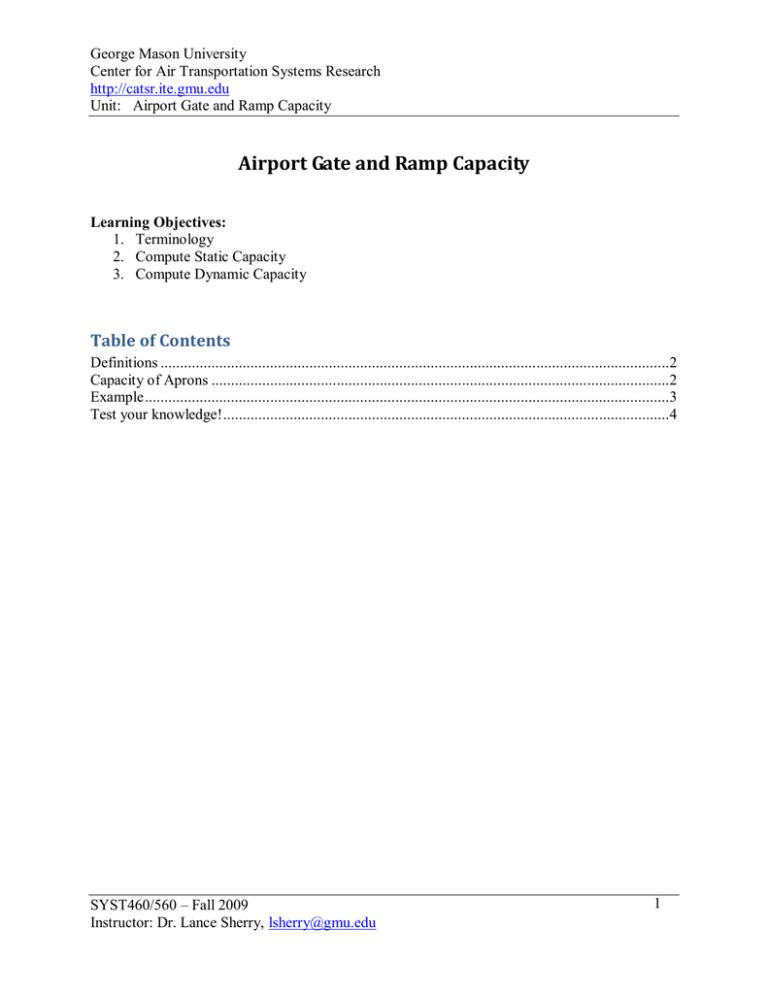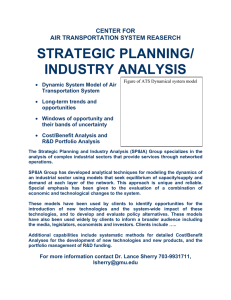George Mason University Center for Air Transportation Systems Research
advertisement

George Mason University Center for Air Transportation Systems Research http://catsr.ite.gmu.edu Unit: Airport Gate and Ramp Capacity Airport Gate and Ramp Capacity Learning Objectives: 1. Terminology 2. Compute Static Capacity 3. Compute Dynamic Capacity Table of Contents Definitions ..................................................................................................................................2 Capacity of Aprons .....................................................................................................................2 Example ......................................................................................................................................3 Test your knowledge! ..................................................................................................................4 SYST460/560 – Fall 2009 Instructor: Dr. Lance Sherry, lsherry@gmu.edu 1 George Mason University Center for Air Transportation Systems Research http://catsr.ite.gmu.edu Unit: Airport Gate and Ramp Capacity Definitions Aprons consist of areas reserved for remote and contact aircraft stands and taxi-lanes. Stands categorized as: 1. Exclusive use – used by a single airline (or a group of airlines). Assignment of use and schedule is managed by the airline (or a contractor responsible for ramp handling in that part of the apron). 2. Shared (or Common) used by more than one airline. Assignment of use and schedule is managed by the airport (or a contractor responsible for ramp handling in that part of the apron). Stands characterized by size – the dimensions of aircraft it can accommodate Capacity of Aprons Static Capacity = number of stands available. Number of aircraft that can occupy the apron at any given moment. Provides snapshot of instantaneous capacity of the apron. Note: Cannot be used for comparison with other parts of airport (e.g. runways) that are characterized by the number of units per unit time. Dynamic Capacity = Number of aircraft per hour that can be accommodated by the stands Considers the time interval between successive occupancies by two different aircraft o Minimum interval = SOT + PT + Buffer Time o time aircraft scheduled to spend at stand = Scheduled Occupancy Time (SOT) = Schedule Turn-around Time (STT). SOT = 20 mins for quick turn or small aircraft SOT = 4 hours for large aircraft on inter-continental route o time to position aircraft into and out of stand Positioning Time (PT). PT = 2-4 minutes for remote stands. PT = 10 minutes for contact stands due to push-back manuever o Buffer Time (BT) to ensure that there is sufficient time between scheduled departure time of the 1st aircraft and the scheduled arrival time of the 2nd aircraft to ensure with high probability that deviations in departure/arrival schedules will not necessitate a change in stand assignment. Note last minute stand assignments are costly and disruptive for passengers and ground personnel BT = 4 minutes for remote stand BT = 1 hour for larger aircraft on contact stand SYST460/560 – Fall 2009 Instructor: Dr. Lance Sherry, lsherry@gmu.edu 2 George Mason University Center for Air Transportation Systems Research http://catsr.ite.gmu.edu Unit: Airport Gate and Ramp Capacity Example Airport has 60 stands. All stands accommodate same size of aircraft. Average SOT = 50 minutes. Analysis based on SOT: Number of aircraft per hour = number of stands/time per stand = 60/(50 mins * 1/60) = 72 aircraft per hour Maximum Capacity (assuming aircraft arrive and depart exactly on schedule). Analysis based on SOT and PT = 60/[(50+8)/60] = 62 aircraft per hour Conservative capacity (BT = 30 minutes) = 60/[(50+8+30)/60] = 41 aircraft per hour SYST460/560 – Fall 2009 Instructor: Dr. Lance Sherry, lsherry@gmu.edu 3 George Mason University Center for Air Transportation Systems Research http://catsr.ite.gmu.edu Unit: Airport Gate and Ramp Capacity Test your knowledge! 1. Define the following terms: Stand __________________________________________________________________ ___________________________________________________________________________ Remote stand ____________________________________________________________ ______________________________________________________________________________ Contact Stand ____________________________________________________________ ______________________________________________________________________________ Common Use Stand _______________________________________________________ ______________________________________________________________________________ Exclusive Use stand _______________________________________________________ ______________________________________________________________________________ Scheduled Occupancy Time (SOT) ___________________________________________ ______________________________________________________________________________ Positioning Time (PT) ___________________________________________ ______________________________________________________________________________ Buffer Time (BTT) ___________________________________________ SYST460/560 – Fall 2009 Instructor: Dr. Lance Sherry, lsherry@gmu.edu 4 George Mason University Center for Air Transportation Systems Research http://catsr.ite.gmu.edu Unit: Airport Gate and Ramp Capacity 2. Complete the following table: Scheduled Occupancy Time Positioning Time Buffer Time Remote Stand Contact Stand – Regional Jet/Narrow Body Contact Stand – Wide-body 3. Compute Apron Capacity: 3-a) Calculate Maximum Apron Capacity AND Estimated Apron Capacity for an airport with the following characteristics: [picture of airport with stands identified = 30 stands] 3-b) SOT = 50 minutes PT = 8 minutes BT = 30 minutes What is the benefit of adding an additional gate. Explain. SYST460/560 – Fall 2009 Instructor: Dr. Lance Sherry, lsherry@gmu.edu 5




